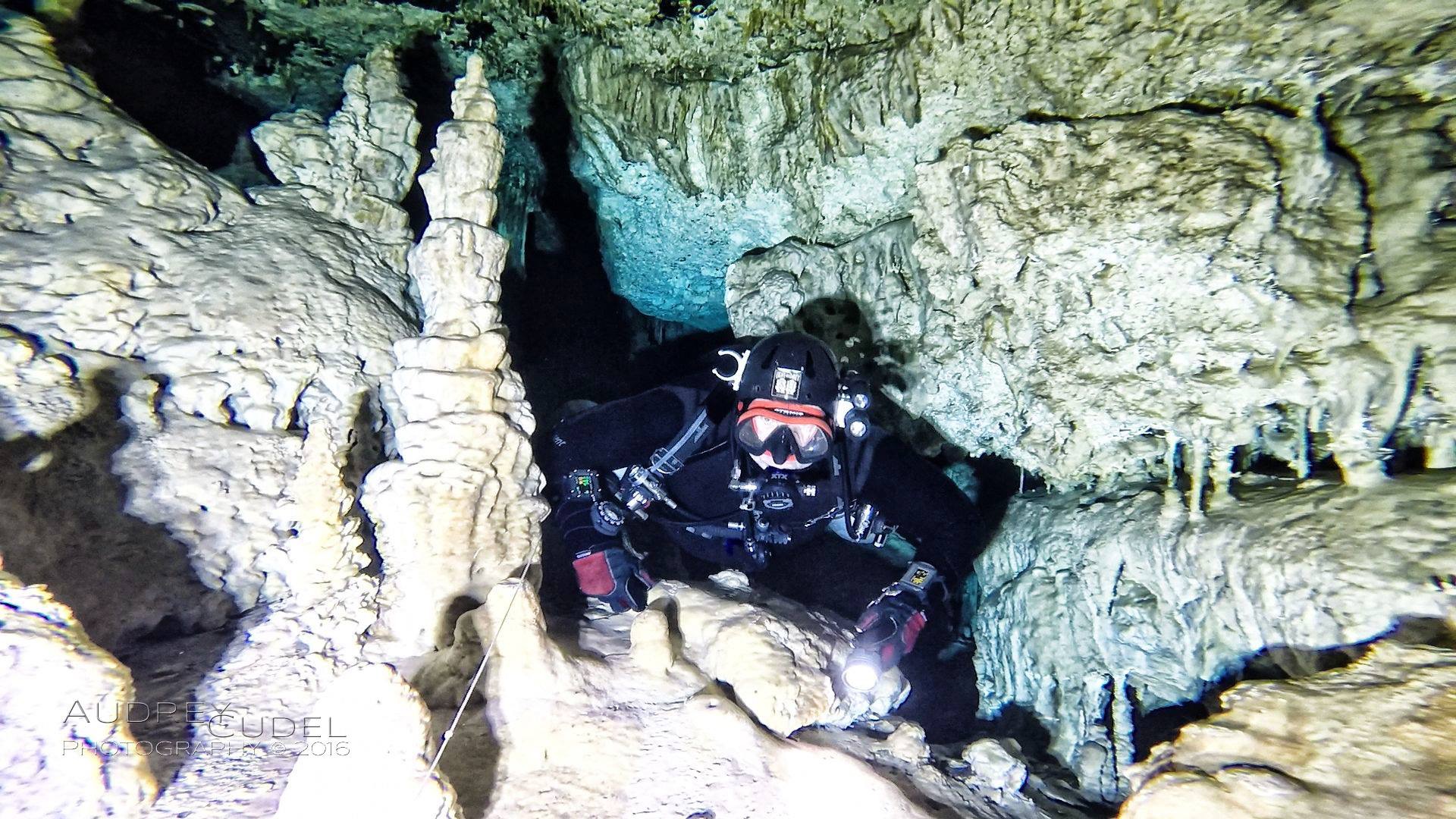[et_pb_section admin_label=”section”][et_pb_row admin_label=”row”][et_pb_column type=”4_4″][et_pb_text admin_label=”Text” background_layout=”light” text_orientation=”left” use_border_color=”off” border_color=”#ffffff” border_style=”solid”]
I highly recommend you read parts 1 and 2 first. Also bear in mind reading this does not give you the psychological skills. Psychological skills are harder in many ways to learn and become expert at than physical skills. They need clarity, they need consistency, and they need a lot of practice and repetition. Just like the physical skills, this needs to be quality practice, with real intent and purpose.
So let’s look at in water.
As we dive there are a great number of stimuli and occurrences that can cause us to have a stress reaction. Some of these are obvious and immediate, free flowing regulator, burst hose, silt out. Others are more insidious, onset of thermal stress, dehydration and often narcosis. Developing appropriate and timely reaction to these is vital. Let’s look at a real life example.
Towards the end of a 65m trimix dive on open circuit, I returned to the shot to see it bouncing across the sand. With my team mate we recovered the shot, causing us to both exceed planned depth and time. It was vital we did this as we we had a second team behind us on the wreck we were responsible for. We began our ascent having resecured the shot. At 48m the shot line started to spool down past us and we just caught the end. I attached a bag and sent the line back up. After adjusted stops we reached 9m and the bag! A second bag was sent up and the reel tied off to the shotline re-establishing a continuous line to the surface for team 2. Deco cleared we headed to the surface to find no boat. 5 mins later it joined us. Team 2 surfaced safely a few moments later.
As each stressor occurred, a decision on a course of action was required. There were a few correct options for each stressor, the trick was having a clear enough head to make the right one, and in the right time frame. Note I didn’t say quickly. Undue haste can often exacerbate stress exponentially. What helped?
First we were on trimix! This negated the compounding stress effect of both narcosis and the physiological stress of undue gas density. A clear and calm head is invaluable. Psychologically knowing this, as well as the actual “real” effects is a massive contribution to high confidence levels. Ensure your gas is right for your dive!
Next, both my team mate and myself were experienced at that depth and although we hadn’t dived together before, we had carefully rehearsed the dive plan and our roles. We knew what to expect from each other. We had confidence in each other skills and abilities. Starting with high confidence levels is a huge advantage. It’s rather like having an airbag, as the stress hits, it cushions the blow.
As we saw the shot bouncing the first reaction from me and my team mate, was a gas and deco time check. As tempting as it might have been for either of us to chase after the shot to what turned out to be 73m, without that sanity check, we could have jeopardised a safe dive exit for both of us. However, we can’t accept that a gas and time check is the most appropriate response to every stressor. What if I’d had a low pressure hose cut on the wreck? All checking gas would do is add to the stress and take the solution (a shutdown) further down the timeline. The same with the stop, breathe, think, act reaction that’s often suggested.
What I prefer is to use the acronym START to ensure that I have prepared responses for all foreseeable issues that can occur on a dive and that I check that these work. STAR in water. T out. Where possible the responses should be similar, but, if we rehearse these responses they do not need to be, and, as we can see from the above, it’s not appropriate that they are all the same. The response should fit into this order.
S elf
T eam
A ction
R eview
T hink
Let’s look at each part.
Self.
Your first recourse in any stressful situation is yourself. Therefore it’s you that needs the first attention, you have to get a grip on yourself and the relationship you have to the stress. The best way of doing this is to use a technique called anchoring. Anchoring brings the psychological and physical attention back onto you in a controlled way. A deep breath is often a good anchoring technique, but for reasons previously discussed I’m not a fan for diving. My preference is to go for another physical reference. At the same time, I use a keyword that I only ever use in a situation where I need to bring attention back to me. Mine is ‘focus matt’ and putting my hands on my valves.
Then it’s about accurately and quickly identifying the stressor source. What do I mean by this? Well on CCR or from your dive computer an alarm is a stressor, but it’s not specific. It could be an ascent rate warning, a cell warning, a low PO2. Other than drawing your attention to the source issue, the alarm is actually no use to you and often is a source of increased stress (I quite often want to take a large rock to someone’s constantly beeping computer!). We need to condition ourselves, through training to respond to alarms with a calm, “right, what’s that!?” as opposed to a fluster of agghh’s and oh sh*ts. Accurate ID of the issue and a good assessment of our ability to cope with it, is of more value. Not once in my training though did I ever have an alarm beep or buzz simulated. I had the issues simulated, high po2 etc. We need to add simulated alarms into training, physical and mental, especially for ccr.
So my reaction to an issue is ideally, centre (hands on valves), self referenced talk to myself, “focus matt”, then identify the issue. This takes about 0.5 of a second to 2 seconds max, depending on the issue ID complexity. If the issue is critical I’m also perfectly placed to respond as anything critical probably involves gas loss! I then decide if action is needed, based on previously trained and well practiced responses, then I implement the response. The better trained I am, the more I have physically practiced the response skills, the more recently I’ve practiced the skill and if I’ve previously used imagery to really embed the response, then the faster I will react.
Team. I need to check how my team has responded to my issue. A well practiced and rehearsed team will be right by me by now, especially if my chosen solution has, as it should, included a clear signal to them. At this point they are checking my issue diagnosis, checking the response I’ve made or am making for correctness, helping out if that’s the way we practice as a team and most importantly checking my head / emotional state is ok.
Action. What next? Abort the dive, check gas and deco penalty and solve the bouncing shot issue as above? Here the team should be involved, either to implement a pre planned action (light failure in cave – exit) or to check recalculated turn pressures or deco requirements. The key here is this is a decided action, based on having averted the immediate crisis and is done in a minimal stress level situation.
Review. At the most appropriate point, the immediate response, the solution and the teams responses and determined action should be reviewed. This should be as soon as possible. Maybe once back at the shot, maybe once on the longer 9 or 6 deco stops. If the soonest most appropriate time is back on the boat or at the dive centre, then that’s when it’s done. Hopefully what your then doing is just affirming all the right steps were done. If not then there’s a training issue. If so, think.
Think. Did the incident occur due to lack of training or practice? Was it a skills failure or a clarity of thought and action failure. How did you feel as the incident unfolded. As it happened above, I was pretty much just having a slightly frustrated swear. If my reaction had been more intense or involved uncertainty or even early signs of undue stress or panic, regardless of having solved the issue, I would have set up and practiced scenarios on a controlled training dive until I was very confident in my solution. Don’t just be pleased with yourself that you “got away with it”. Be self critical. If you don’t know how you got away with it seek advice from an instructor (not the Internet forum or your mates).
There are issues here then for your training. Good dive instructors will expose you to 95% of the potential stressors you will face. They will train you and encourage you to practice the appropriate response and repeat until the techniques become skilful and second nature. In dive planning your instructor will ask you to do a ‘what if’ plan (plus 3m plus 3 mins) plus what if x or y happens. The further into tech or cave you go, the more skills and responses you learn. Try this though. Write down 10 problems that can occur on a dive, not too common. Now write down your response. Was there enough detail in the response to meet the start criteria above? Is there something in there that focuses you and depowers any emotional reaction. Can you close your eyes and using your imagination, see, feel and hear clearly (imagery) the issue and response. If so, great. Experience and great training has developed the right mental approach. If not then purposeful practice is required.
Next time out, we’ll discuss imagery in more detail.
Please like the page, not just the post and select following to get the posts.
[/et_pb_text][/et_pb_column][/et_pb_row][/et_pb_section]




